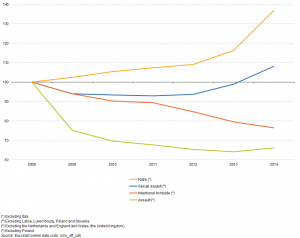Terrorism: what managers can do
Another attack, another occasion where political short-term considerations fill scarce space on the public agenda. Facing the problem of terrorism and of a youth in despair in many European cities and regions is of utmost importance. However, finding effective solutions can only come from keeping a cool head and analysing the current situation.
As one of the six officially recognised European Social Partners, we see it as our duty to contribute to this important debate, founded on some of the most important values we have in Europe: freedom and security. This article provides a short overview about the situation of terrorism in Europe, what managers can do in their working environment and how public policies can support preventive and emergency measures.
Terrorism in Europe
Terrorism is commonly understood as a phenomenon aimed at causing death or injury, undermining (democratic) governance and creating a state of terror in the population. Terrorism can be motivated by various considerations, including philosophical, ideological, racial, ethnic, religious and other reasons. There is no single profile of individuals who have become involved with terrorism, no stereotypical profile based on “race”, ethnicity, sex, or socio-economic status. Radicalisation occurs in an interactive process between individual and external influences, such as the workplace, friends, families and terrorist recruiters (1).
Looking at the statistics about terrorism in Europe, the following graphic shows that terrorism-related deaths have a much longer history than the one of Islamist terrorism.

Graphic 1: Terrorism in Europe – deaths per month
source: Washington Post 2016 (link)
 Furthermore, when comparing the number of terrorism-related deaths with the general homicide and criminality rate (terrorism-related deaths are counted as homicides), then the relative weight of terrorism is quite low. In 2015, around 4500 homicides were counted in the EU28 (2). As for the development of homicides, the number of reported incidents is even decreasing since 2008, while incidents of rape have increased considerably (3).
Furthermore, when comparing the number of terrorism-related deaths with the general homicide and criminality rate (terrorism-related deaths are counted as homicides), then the relative weight of terrorism is quite low. In 2015, around 4500 homicides were counted in the EU28 (2). As for the development of homicides, the number of reported incidents is even decreasing since 2008, while incidents of rape have increased considerably (3).
Graphic 2: Police recorded offences by category
source: Eurostat (link)
Even though these figures limit exaggerations regarding the danger for life in numbers, they do not say much about the qualitative aspects of terrorism and related fears. A permanent media stream on terrorism, paired with a considerable strengthening of the security-focussed political discourse (4) leaves its traces in the public opinion with 40% of EU citizens thinking there was a “high risk” of terrorist attack in their country (5).
Types of measures against terrorism
When speaking about measures against terrorism, short and long-term measures should be differentiated. To effectively combat terrorism, individuals, organisations and societiy need to get more resilient and active on multiple levels. Above all, it is important to not enter a destructive spiral of fear and political short-sightedness.
The most obvious measures are reactive emergency policies in the case of an attack, or the question of how to limit potential damage. So-called “all hazards approaches” help organisations or government agencies to assess and evaluate diverse risks and possible responses to major natural and man-made disasters. It is important to not focus on single risks, like terrorism, because such attitude can overshadow other risks or reduce resources to improve emergency responses in other domains. For example, due to a shift in priorities (focus on terrorism), US Federal and local governments’ mitigation, response and recovery measures to the Hurricane Katrina were not adequate (6). Security management in organisations strategizes on how to protect the assets, data, health and security of employees, and on how to ensure security when facing various risks.
Regarding longer-term measures, the UN Global Counter Terrorism Strategy defines a holistic approach to counter terrorism that includes (7):
- Measures to address conditions that are conducive to the spread of terrorism;
- Measures to prevent and combat terrorism; and
- Measures to ensure respect for human rights for all and the rule of law as the fundamental basis of the fight against terrorism.
The first type of measures comprises security policies aimed at suppressing financial flows or recruitment networks among others.
More important for most managers, is the second set of measures. When speaking of prevention, a wide range of actors is implied. Here is what managers can do in the workplace.
First, it is about identifying possible conditions conducive to terrorism and not about identifying stereotypes of terrorists that do not exist in reality (1). The UN and the OSCE recognise the following: “prolonged unresolved conflicts, dehumanization of victims of terrorism in all its forms and manifestations, lack of rule of law, violations of human rights, ethnic, national and religious discrimination, political exclusion, socio-economic marginalization and lack of good governance.” Other factors, such as human rights violations (including those resulting from counterterrorism measures), relative deprivation, a lack of access to education, psychological, interpersonal or ideological problems may also favour radicalization leading to terrorism (1).
Second, acting in the workplace means to avoid facilitating factors: negative feelings of displacement, of “being odd”, i.e. feelings of exclusion, rejection, relative deprivation, humiliation, victimization, injustice, frustration, revolt or superiority. It is also important to counter narratives and ideas that are either legitimizing or playing down terrorism and its ideology. More concretely, managers can create safe spaces, establish psychological counselling (sometimes in the form of a trustworthy contact person) or mentoring, encourage civic engagement, arts or sports. Also developing critical thinking and self-reflection is important to empower people to question own assumptions and those of others (8).
Finally, it is important to embed these considerations into a strategic approach of (general) risk prevention. Company policies in the fields of equality, discrimination and (e)safety, rules of conduct, whistle-blowing policies or others may contribute to reduce radicalization risks, but also others like mental health risks.
The last type of measures, mentioned earlier, becomes more and more relevant to managers in the light of the mentioned security-focused policy discourse. Here too, it is about analyzing the situation and risks, while balancing them with the respect of human rights (liberty, privacy, security etc.) and labour legislation. Companies can take a proactive stance by engaging with civil society organisations, promoting fundamental values and human rights, participating in public dialogue and of course, influencing the political agenda for a more balanced and long-term approach to counterterrorism.
Sources
(1) OSCE 2014: p. 35, 36. Preventing Terrorism and Countering Violent Extremism and Radicalization that Lead to Terrorism: A Community-Policing Approach. http://www.osce.org/atu/111438?download=true
(2) Eurostat (2008 – 2015): http://appsso.eurostat.ec.europa.eu/nui/show.do?dataset=crim_off_cat&lang=en
(3) Eurostat 2016: http://ec.europa.eu/eurostat/statistics-explained/index.php/Crime_and_criminal_justice_statistics
(4) Egmont institute 2016: http://www.egmontinstitute.be/content/uploads/2016/09/SPB77.pdf?type=pdf
(5) Special Eurobarometer of the European Parliament 2016: http://www.europarl.europa.eu/pdf/eurobarometre/2016/attentes/eb85_1_synthesis_perceptions_wishes_terrorism_en.pdf
(6) Brookings 2013 https://www.brookings.edu/opinions/counter-terrorism-and-emergency-management-keeping-a-proper-balance/
(7) The UN Global Counter Terrorism Strategy, op. cit., note 8; OSCE, “Ministerial Statement on Supporting the United Nations Global Counter Terrorism Strategy”, op. cit., note 20
(8) OSCE 2014: p.46. Preventing Terrorism and Countering Violent Extremism and Radicalization that Lead to Terrorism: A Community-Policing Approach. http://www.osce.org/atu/111438?download=true




